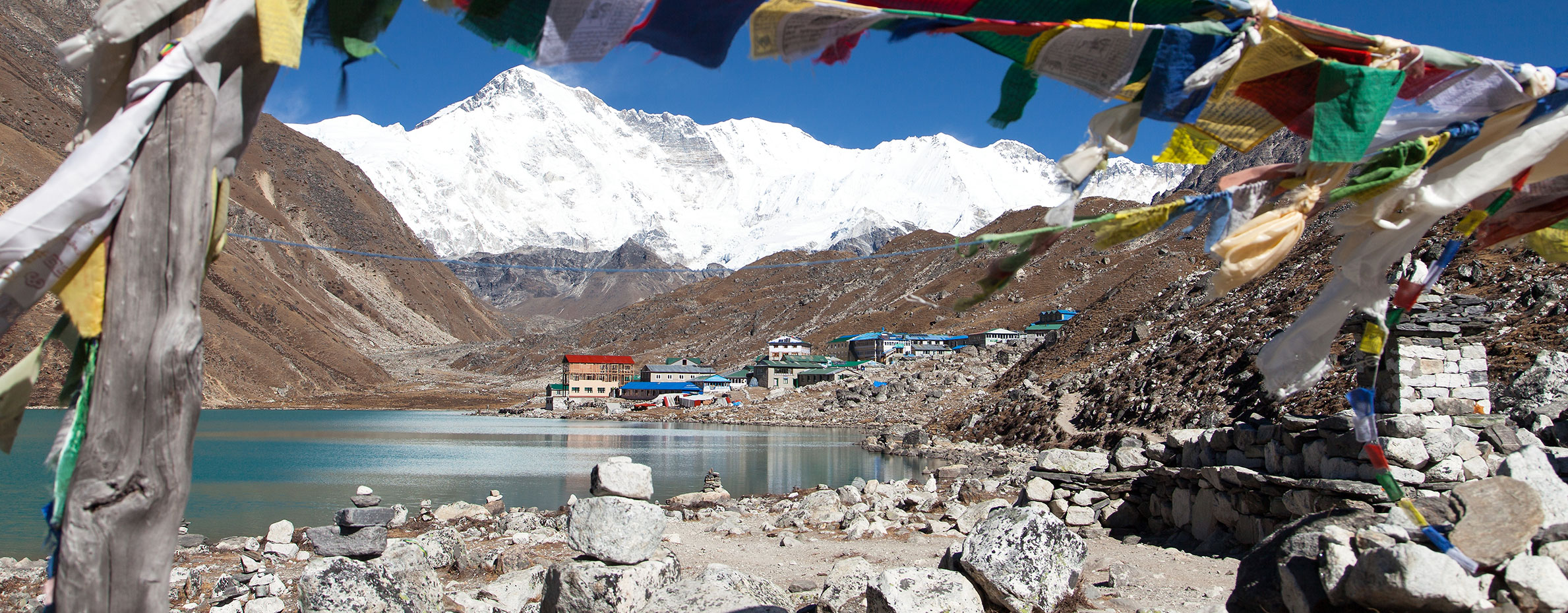Gokyo Trek is a captivating journey of exploring the sacred (of Hindu and Buddhist religion) lake, Gokyo, at 4,750 meters/15,584 feet. The Gokyo Lakes trek is among the shorter and more accessible trekking alternatives in the Everest region and the best way to explore the Himalayan wonders at the foothills of the lofty Mount Everest.
If you are considering visiting the enchanting Gokyo Lakes, surrounded by towering mountains, the most suitable time for an extraordinary experience would be during the favorable trekking time in November. November, the high time for Himalayan trekking, sees the Gokyo Lakes teeming with radiance. The surreal reflection of the majestic Himalayas over the surface of sparkling lakes fascinates the visitors.
The exhilarating trekking adventure of Gokyo takes you through the pristine wilderness of the hidden Gokyo Valley to one of the highest freshwater lake systems in the world. Thonak Cho (largest), Ngozumpa Cho (smallest), Taujung Cho, Gyazumpa Cho, Longpongo Cho, and Gokyo Cho (main lake, also known as Dudh Pokhari) are the six glittering Gokyo Lakes located in the Sagarmatha National Park at an altitude of around 4,700-5,000 meters. This adventurous trek to the Gokyo Valley, with six beautiful lakes, is most remarkable during one of the peak trekking months, November.
While visiting Gokyo Lake in November, you can experience a solitary trekking adventure in a less crowded, peaceful, and relaxed environment. Traversing the remote, off-the-beaten trails of the hidden valley, you can immerse yourself in the beauty and tranquility of the high Himalayas.
Besides, trekking Gokyo Lakes in November allows you to participate in a traditional Mani Rimdu festival of a Sherpa community. This festival is greatly celebrated in the Everest region, which adds depth and richness to the cultural dimension of the trek.
Gokyo Trek Experience in November

- Stunning view of Ngozumpa Glacier and shimmering Gokyo Lake
- Chances of spotting precious birds and wildlife of the region like snow leopard, Himalayan tahr, red panda, Himalayan black bear, golden eagle, blood pheasant, Himalayan Monal, and more, who increase their activity to prepare for winter hibernation
- Rich insights into the diverse flora, fauna, and vegetation of the while traversing the captivating landscapes of the Sagarmatha National Park
- An enriching trekking experience in stable weather and milder temperature conditions of the month
- Sharp observation of eye-catching lofty mountains against the clear blue skies
- Captivating view of sunrise and sunset from the Gokyo Ri viewpoint
- Upgraded visibility of the captivating Himalayan terrains
- Dry trekking trails due to less or no rain reduce the problem of muddy and slippery trails and allow for a comfortable walk
- Light snowfall gives the touch of a magical winter wonderland
- Himalayan landscapes seem glittering with a thinly covered snowflake
- Unobstructed views of the mountainous surroundings in enhanced clarity
- Experiencing a vibrant teahouse environment with an opportunity to socialize and taste the delicacy of local dishes
- Chance to partake in the local celebrations
Is November a Good Time for Gokyo Trek?
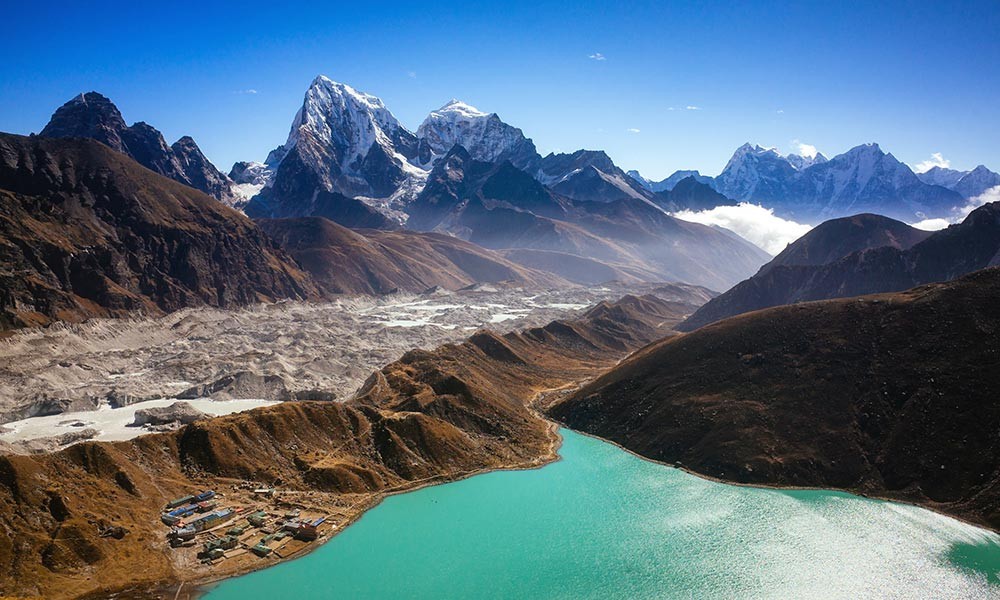
Generally, spring and autumn seasons are considered the best time for high-altitude Himalayan adventures. Among them, November stands out as the driest and clearest month of the whole year. This is also the final month of peak trekking season before the onset of winter.
Although the Gokyo Lakes trek is a year-round adventure, for an unforgettable and immersive experience, you can opt for a favorable trekking month, November. It is indeed a good time for the Gokyo trek when the true essence of the untouched Himalayan region and turquoise Gokyo Lakes can be experienced.
November is an excellent time for trekking enthusiasts with cool and mild weather conditions. It is not sweltering as summer, wet as monsoon, and frigid as winter. Unlike in winter, the snowfall is less, and the air is clear, offering magnificent views of the mountainous scenery all around. The views of enchanting Himalayan landscapes and snow-covered mountains in November are splendid with unparalleled clarity.
November Temperatures and Weather for Gokyo Lakes Trek
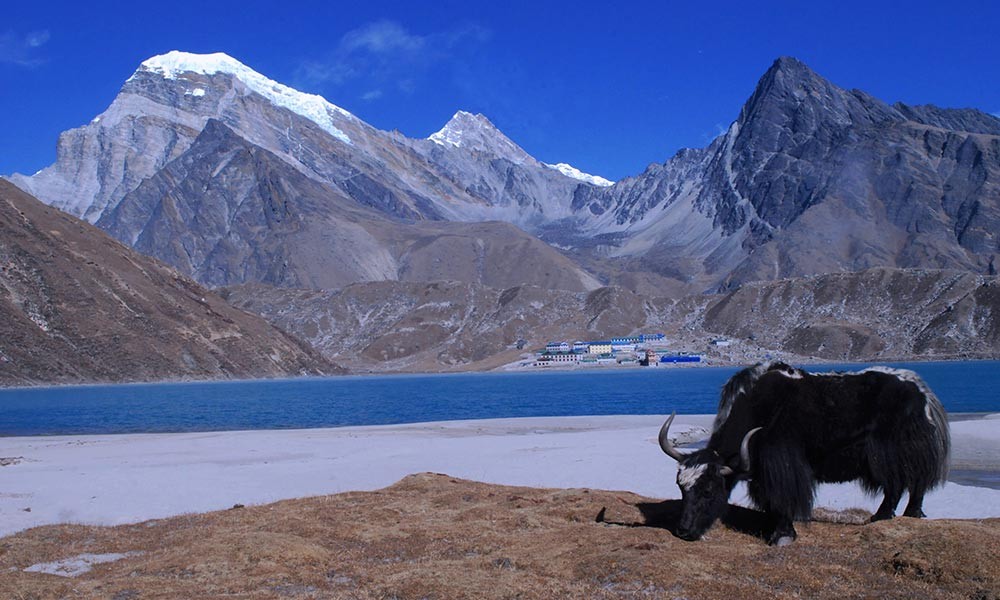
November is a transition month from autumn to winter, so temperatures start to drop as the month progresses. The average daytime temperature in November remains around 10 to 18 degrees Celcius. So, you can enjoy the pleasant temperatures during your trekking days. However, at high altitudes, the early morning and night can be colder, with temperatures dropping as low as 1 to -10 degrees Celcius. As the weather starts to get colder at the end of November, you should pack warm layers of clothes for a cozy and delightful experience at the alpine altitudes.
In early November, days are generally bright and sunny, with a mild climate and clear skies. The open views of mountains glistening with snow are captivating. The weather is quite stable, allowing for an enjoyable trekking experience. The humidity level in the air is low, and the chance of rainfall is scarce during this time. So, November features dry climatic conditions, which is perfect for comfortable and smooth trekking activities.
Besides, a Gokyo trek in November also allows you to experience the early winter vibes in the mountainous surroundings. At times, there can be light fur-like snowfall, transforming the Himalayan landscapes into a snow paradise. As the snowfall is faint and occasional, there won't be any difficulties in navigating the trails. En route, you will encounter lush vegetation, cascading waterfalls, vibrant rhododendron forests with a sweet aroma, cultural villages, and more, which makes the Gokyo trek in November an unbeatable experience.
Why Gokyo Trek in November?
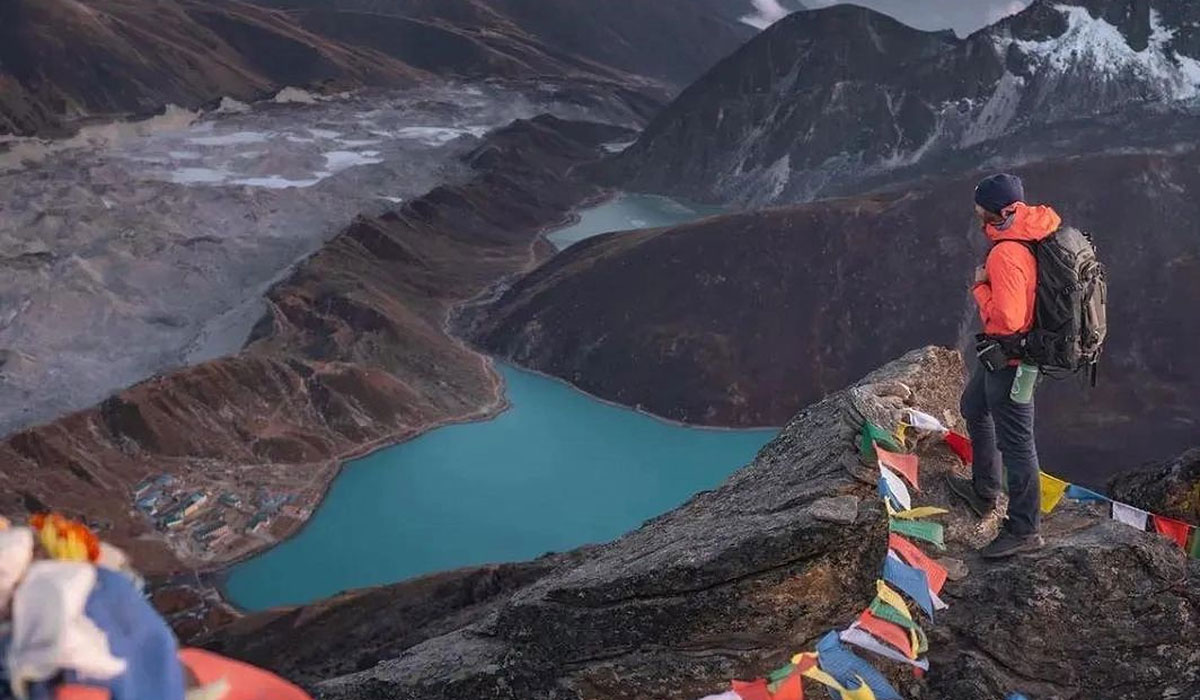
Unobstructed Views
During your Gokyo trek in November, you can enjoy the most spectacular views of pristine white hues mountains shining against the clear blue skies. November is a time of low humidity and reduced precipitation, which makes the Himalayan atmosphere clean and fresh. The climate gets drier, and the sky gets clearer than ever. The undisturbed, stable atmosphere and crystalline skies offer the best conditions to witness the pristine glory of magnificent alpine landscapes and majestic peaks in sharp visibility.
Although light snowfall can occur in late November as winter closes, it will not prevent you from thoroughly observing the breathtaking Himalayan scenery. So, November is a popular choice among trekking enthusiasts who want to relish the unobstructed views and beauty of the high Himalayan region along with the serene winter atmosphere.
Transitioning Climatic Conditions
Autumn is towards its end in November. This is the time when you can experience the remnants of autumn with cool temperatures, which is transitioning into winter with crisp mountain air. As November is onward to the onset of winter, you can experience light snowfall, mostly during the later days. This makes early November the beautiful phase of autumn, which is far from the occasional post-monsoon rain of September, and full-fledged winter is still a few weeks away.
Although it gets colder towards the end of November, the Everest region will not experience intense cold and heavy snowfall like that of peak winter months (December to February). While the mornings and evenings are cool and breezy, the bright, sunny days are ideal for relaxed and enjoyable walks.
Captivating Fall Landscapes
The Gokyo trek in November offers you a unique opportunity to experience the stunning fall landscapes of the Everest region. November is way far from the monsoon, and winter is yet to come. This is the phase when you can see the stunning visual of crimson-grey foliage in the high Himalayas.
As the trees shed colorful leaves over the landscapes, they transform into a vibrant and picturesque environment. While traversing the forested trails, you can see the diverse shades of fall foliage (red, orange, brown, and yellow) covering the trekking trails. The exceptional views of white hues peak over the background of color-rich landscapes offer a phenomenal contrast and visual splendor.
Moderate Trekking Crowds
Spring and autumn are the most preferred seasons for trekking adventures in the Himalayas of Nepal. Although November is a high time for Himalayan trekking adventures, this fall month relatively receives fewer trekkers. So, skipping the flock of trekkers to the Everest Base Camp trails during one of the busiest trekking seasons is easy in November. In addition, the Gokyo Lakes trek follows the remote trails of the Everest region, and the crowd to explore the back hood areas of the Gokyo Valley is even smaller.
Due to fewer crowds on trekking trails, you can experience a tranquil and nonchalant journey. You do not have to rush to the accommodations as they are easily available at this time. Also, you can have a relaxed exploration of the attractions of the journey.
Food and Accommodation During the Gokyo Trek in November
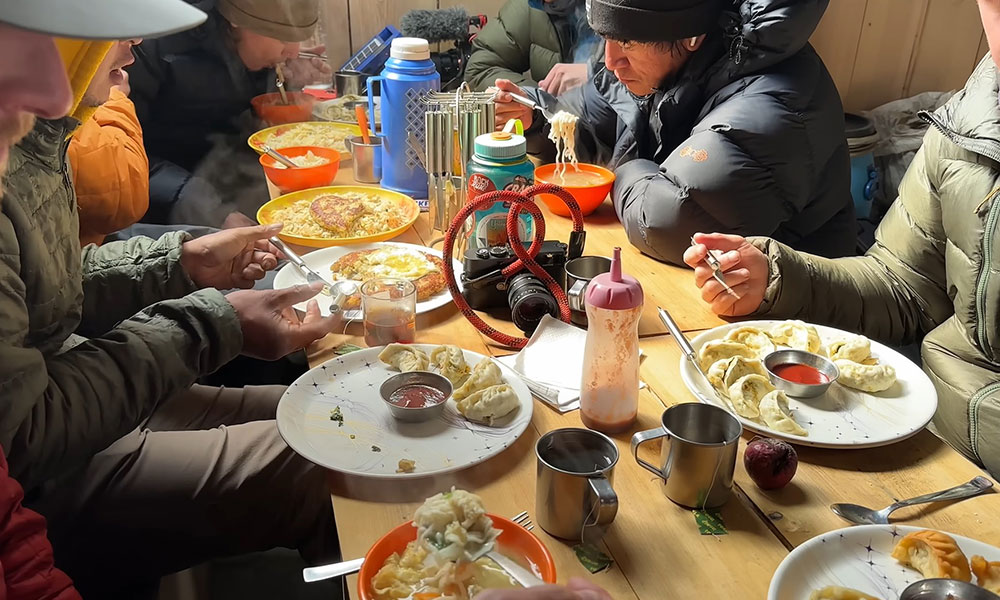
During our 14-day Gokyo Lakes trek, you will spend 3 nights in a twin-sharing room at the standard hotel in Kathmandu, where you can enjoy the comfort of modern amenities. Similarly, during the trekking journey, we will book you at the best teahouses available on the trekking routes.
Lodges and teahouses are the commonly available forms of accommodations during a high-altitude Himalayan trekking journey. So, during your Gokyo trek in November, you will spend cozy and comfortable nights at traditional Sherpa teahouses. Throughout the trekking adventure, you will enjoy a variety of dishes at these local teahouses, from traditional mouth-watering delicacies to several popular Western dishes.
The accommodation in teahouses will be simple with basic amenities. You can expect ordinary bedding with a set of pillows, a warm blanket, and mattresses. As November slowly leans towards cold winter and if you are insufficient with these supplies, you can bring your sleeping bags for added warmth and comfort during the teahouse nights.
The teahouse rooms are available in shared options with two to three beds in a single room. Likewise, toilets and bathrooms are also available on a sharing basis. There is a communal dining area in teahouses with fellow trekkers enjoying hearty dishes. This gathering creates a lively atmosphere, and you can get a chance to communicate and connect with travelers of diverse backgrounds, socialize, and share stories.
Your trekking days on the exciting Everest Base Camp trekking routes start with a light and delicious breakfast in teahouses. Breakfast menu items mainly include Sherpa bread, Sherpa pudding, paratha, oats, cornflakes, pancakes, salad, etc. Also, you enjoy a variety of hot and cold drinks like tea (of honey, butter, ginger, milk), coffee (milk and black), fruit juice, etc.
For lunch and dinner, you can enjoy tummy-filling nourishing cuisines such as traditional dal bhat (a chief meal at teahouses with rice, lentil soup, and pickles), Sherpa stew, Gundruk and dhindo, momo (dumplings), Chowmein, Thukpa and more. You can also enjoy the taste of some international cuisines like pizza, pasta, burgers, sandwiches, etc.
Note for accommodation: Teahouse facilities and availability get lower with the rise in elevations, and you can get hot showers, internet connections, and electronics charging at additional costs.
Note for food: Both veg and non-veg food options are available in the teahouses. You can also place a special order for a meal according to your dietary plan or request to exclude the ingredients that you do not especially prefer.
You may also like:
Is Gokyo Lake Trek Difficult?
The Gokyo Lakes trek is not a very difficult journey. The exhilarating trek of the pristine Gokyo Lakes is taken as a moderately difficult adventure. Its mild trekking trails are accessible to adventure enthusiasts with diverse skills, experiences, and capabilities. Traversing the average routes of the trek, you will undergo a significant test of your stamina, acclimatization strategies, and trekking aptitude.
For a successful Gokyo Lakes trek, you need to have proper physical fitness, strength, and endurance capacity to overcome its high altitudes and variable terrains. You should be well-prepared for extensive days of walking over the rugged trails with steep ascends and descends. While no technical climbing skills are required, some sections of the trail may involve rocky terrains and high mountain passes.
The highest point of the Gokyo Lake trek is Gokyo Ri, at 5,357 meters/17,575 feet. The top of this vantage point rewards you with an expansive panorama of the breathtaking Khumbu Himalayas, including Everest, Makalu, Lhotse, Cho Oyu, Cholatse, Ama Dablam, Thamserku, Taboche, and other neighboring peaks. However, you need to follow proper altitude acclimatization and deal with potentially challenging weather conditions of the alpine regions for a smooth and enriching experience of the Gokyo Lakes trek. Also, it is essential to be prepared with appropriate gear and clothing and hire guides and porters to experience safety and comfort throughout the journey.
Is There a Chance of Altitude Sickness?

The Gokyo Lake trek is a high-Himalayan adventure, and the altitude can elevate the difficulties of the journey. You will spend several days on the trek at over 3,000 meters altitude, and you will be above 5,000 meters during the hike of a Gokyo Ri. So, there is a possibility of being susceptible to altitude sickness because of thin air and low oxygen levels at higher elevations.
The prime mitigating measure for altitude sickness is to keep a slow pace of ascent by allowing ample time for acclimatization, which helps to adapt to changing altitudes. Next, descend down to familiar elevation points and acclimatize there until the altitude symptoms (headache, nausea, dizziness, rapid heartbeat, breathing difficulty, etc.) are fully recovered. Also, keep yourself well-hydrated throughout the journey, which helps to regulate the body temperature and adjust to the lower oxygen regions.

